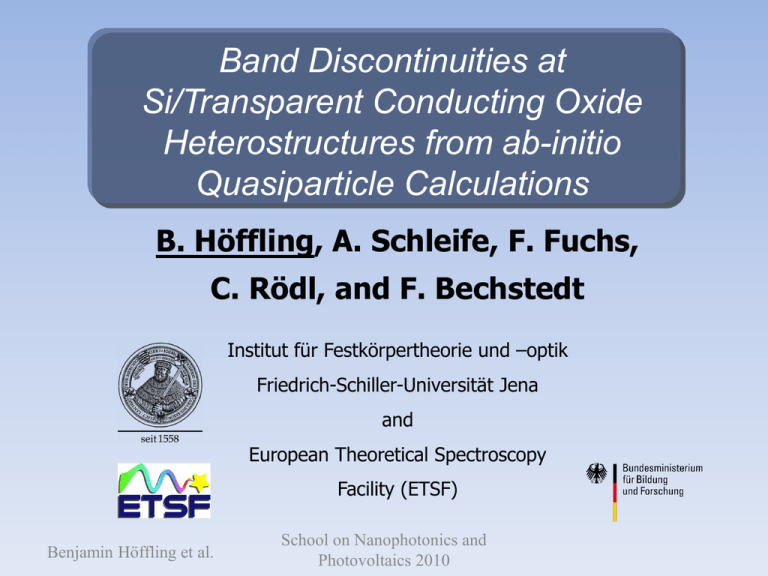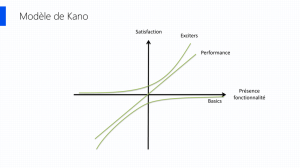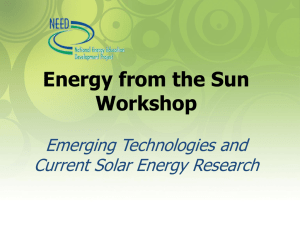ppt - PLMCN10
advertisement

Band Discontinuities at Si/Transparent Conducting Oxide Heterostructures from ab-initio Quasiparticle Calculations B. Höffling, A. Schleife, F. Fuchs, C. Rödl, and F. Bechstedt Institut für Festkörpertheorie und –optik Friedrich-Schiller-Universität Jena and European Theoretical Spectroscopy Facility (ETSF) Benjamin Höffling et al. School on Nanophotonics and Photovoltaics 2010 Outline 1. Motivation 2. Electronic Structure Calculations 3. Mesoscopic Methods 1. Vacuum Level Alignment 2. Branch Point Energy Alignment 4. Comparison of Results 5. Si/In2O3: Interface Model Alignment 6. Summary Benjamin Höffling et al. School on Nanophotonics and Photovoltaics 2010 1. Motivation: Why Si/TCO Interfaces? • Transparent Conducting Oxides like ITO and ZnO are used as transparent electrodes in photovoltaic and optoelectric devices. • Key properties such as ionization energy, electron affinity, charge neutrality level and work function are poorly known. • Electronic properties of Si/TCO heterojunctions determine the efficiency of Sibased solar cells Benjamin Höffling et al. School on Nanophotonics and Photovoltaics 2010 1. Motivation: Electronic Properties of Interfaces - - - + Benjamin Höffling et al. + + School on Nanophotonics and Photovoltaics 2010 - - 1. Motivation: Electronic Properties of Interfaces Type I Benjamin Höffling et al. Type II School on Nanophotonics and Photovoltaics 2010 Type III 2. Electronic Structure Calculations • • Spatially non-local XC-potential HSE03 used for zeroth approximation of XC self-energy QP wave functions used to compute QP shifts using manybody pertubation theory in the G0W0 approach. -> QP band structure of bulk materials F. Fuchs et al., Phys. Rev. B 76, 115109 (2007) Benjamin Höffling et al. School on Nanophotonics and Photovoltaics 2010 3. Methods: Electronic Properties of Interfaces • Si and TCO have – – – Different bond types Different lattice constants Different lattice structures -> Construction of structural interface model highly nontrivial • Mesoscopic methods that don‘t require detailed knowledge of interface geometries can help. Benjamin Höffling et al. School on Nanophotonics and Photovoltaics 2010 Si lattice ZnO lattice 3.1 The Vacuum Alignment Method R.L. Anderson, Solid State Electron. 5, 341 (1962) • requires: ionization energy I=Evac-Ev electron affinity A=Evac-Ec with QP bandgap Eg=I-A Benjamin Höffling et al. School on Nanophotonics and Photovoltaics 2010 3.1 The Vacuum Alignment Method • • • • Electrostatic potential at surface obtained by DFT-LDA repeatedslab supercell calculations Plane averaged electrostatic potential with bulk oscilations and vacuum plateau QP-CBM and VBM relative to electrostatic bulk oscillations known Alignment yields ionization energy and electron affinity Benjamin Höffling et al. School on Nanophotonics and Photovoltaics 2010 CBM VBM I A 3.1. The Vacuum Alignment Method • • • ΔEv=I1-I2 ΔEc=A1-A2 We obtain Type II and Type III heterostructures (exception: SnO2) -> good charge carrier separation Crystal Eg I A ΔEc ΔEv rh-In2O3 3.31 (3.02)a 6.11 9.41 -1.57 3.58 bcc-In2O3 3.15 (2.93)a 5.95 (4.1-5.0)f 9.10 (7.7-8.6)f -1.42 3.27 wz-ZnO 3.21 (3.38)b 5.07 (4.25-4.95)g 8.28 (7.82, 8.35)g,h -0.53 2.34 rt-SnO2 3.64 (3.6)c 4.10 (4.44)i 7.73 (8.04)i 0.44 1.38 School on Nanophotonics and Photovoltaics 2010 3.2 Branch Point Alignment Method: Fundamentals Basic concept: Virtual gap states (ViGS) • V. Heine, SS 2, 1 (1964); PR A 138, 1689 (1965) • E BP EBP is the energy at which the character changes from donor- to acceptor-like behavior We use QP energies to approximate the BZaverage of the midgap energy 1 2Nk k 1 N CB CB i ci (k ) 1 N VB v (k ) i VB A. Schleife et al., APL 94, 012104 (2009) Benjamin Höffling et al. School on Nanophotonics and Photovoltaics 2010 i 3.2 Branch Point Alignment Method: Consequences • • • • Surface/Interface induces ViGS and pinns Fermi level at EBP We use QP energies to approximate the BZaverage of the midgap energy EBP >CBM creates creates charge accumulation layer near oxide surface confirmed for ZnO: M. W. Allen et al., Phys. Rev. B 81, 075211 (2010) Benjamin Höffling et al. School on Nanophotonics and Photovoltaics 2010 3.2 Branch Point Alignment Method • • • • • Crystal Eg EBP ΔEc ΔEv rh-In2O3 3.31 (3.02)a 3.79 (3.50)a -1.48 3.50 bcc-In2O3 3.15 (2.93)a 3.50 (3.58)a -1.35 3.23 wz-ZnO 3.21 (3.38)b 3.40 (3.2, 3.78)d,e -1.17 3.09 rt-SnO2 3.64 (3.6)c 3.82 -1.19 3.53 Type II and Type III heterostructures Branch point in good agreement with experiments EBP> Eg in all TCOs SnO2 now Type II heterostructure Similar values for ΔEv: Common anion rule Benjamin Höffling et al. School on Nanophotonics and Photovoltaics 2010 4. Comparison of Results: Band Lineup Si Interface with via EBP via I and A ΔEc ΔEv ΔEc ΔEv rh-In2O3 -1.48 3.50 -1.57 3.58 bcc-In2O3 -1.35 3.23 -1.42 3.27 wz-ZnO -1.17 3.09 -0.53 2.34 rt-SnO2 -1.19 3.53 0.44 1.38 • • • Benjamin Höffling et al. School on Nanophotonics and Photovoltaics 2010 Good agreement between the two methods Exception: SnO2 Possible reason: no surface states at this orientation 5. Si/In2O3: Interface Model Alignment • • Band offsets via averaged electrostatic potential: ΔEc= -1.07 eV ΔEv= 2.95 eV Shift due to charge transferinduced dipole moment? ( x ) IF ( x ) ( Si ( x ) In 2 O 3 ( x )) • Integration shows a transfer of 3 electrons into the oxide. But: only about 0.5 electrons into the slab. -> ionic component in Si-O bonding Benjamin Höffling et al. School on Nanophotonics and Photovoltaics 2010 6. Summary • • • • • We calculated branch point levels, ionization energies and electron affinities for Si, In2O3, SnO2, and ZnO. Band offsets for Si/TCO interfaces determined by two different alignment methods in good agreement with each other (exception: SnO2) Branch Point Energy Alignment and Vacuum Energy Alignment are usefull tools for the efficient calculation of band discontinuities that don‘t require detailed structural interface models Interface Model Alignment confirms predictions. For Si/TCO heterostructures a tendency for Type II or misaligned Type III heterostructures is observed -> Good charge carrier separation Benjamin Höffling et al. School on Nanophotonics and Photovoltaics 2010 Thank you for your attention! B. Höffling et al., APL 97, 032116 (2010) a P.D.C. King et al., Phys. Rev. Lett. 101, 116808 (2008), P.D.C. King et al., Phys. Rev. B 79, 205211 (2009) b W. Martienssen and H. Warlimont eds., Handbook of Condensed Matter and Materials Data, (Springer, Berlin, 2005) c K. Reimann and M. Steube, Solid State Commun. 105, 649 (1998) d W. Walukiewicz, Physica B 302-303, 123 (2001) e P.D.C.King et al., Phys. Rev. B 80, 081201 (2009) f A. Klein, Appl. Phys. Lett. 77, 2009 (2000) g K. Jacobi et al. Surf. Sci. 141, 109 (1984) h W. Mönch, Semiconductor Surfaces and Interfaces, (Springer, Berlin, 2001) i C. Kiliç and A. Zunger, Appl. Phys. Lett. 81, 73 (2002) Benjamin Höffling et al. School on Nanophotonics and Photovoltaics 2010








